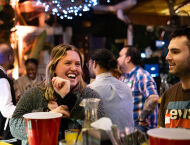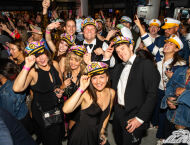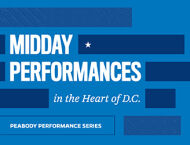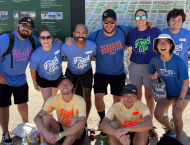Culture
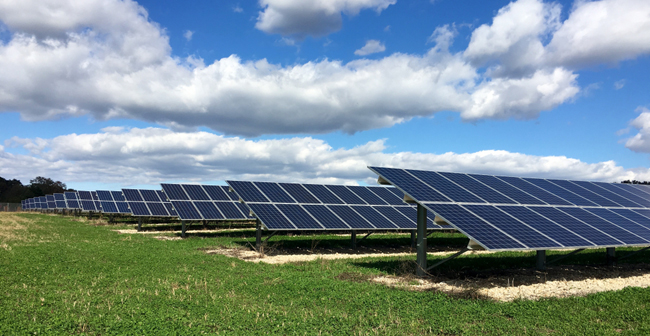 Photo: Courtesy of MOM's
Photo: Courtesy of MOM's
In DC, It Is Easy Being Green
March 31, 2018 @ 12:00am
Though it may not be obvious at first glance, the District is filled with green and sustainable organizations, businesses, events and initiatives. Like many cities around the country, we’re taking the lead on reducing our ecological impact, combating climate change, protecting our air, lands and water, and conserving wildlife. Residents are making a commitment to living sustainably, and city officials are taking steps to reduce waste and protect natural places in the city. From the buildings we live in to the food we eat, DC is slowly but surely becoming a more environmentally friendly place to live – one innovation at a time. Check out our roundup of the great work that people are doing to make the city a little greener – sometimes literally!
Casey Trees
The District has long been known as the City of Trees, and our leafy green streets and parks are part of what makes the city special. The team behind Casey Trees, an organization dedicated to restoring, enhancing and protecting DC’s tree canopy, says that trees in urban spaces have many more benefits than most of us realize.
“Our trees do more than just look beautiful,” says Casey Trees Communications Specialist Jona Elwell. “Trees remove carbon dioxide from the air and produce oxygen, [and] DC’s trees annually store 649,000 tons of carbon, which is the equivalent of removing 506,772 vehicles from the road. Green spaces in cities have been shown to help residents combat stress, anxiety [and] depression, and tree-lined streets have a traffic-calming effect, which keeps drivers and pedestrians safe.”
Casey Trees was founded in 2002, and their work has changed a lot over the past 16 years.
“When we first set out, we didn’t know what our urban forest was made of,” Elwell says. “Now, we’re working to measure and identify every tree in the city, and our volunteers and tree planting department annually plant over 3,200 trees throughout the District. Not to mention, we now have fully fledged pruning, advocacy and children’s education programs, too.”
Casey Trees’ work has expanded, but the mission of keeping DC true to its nickname hasn’t changed.
Learn more at www.caseytrees.org.
City Wildlife
Founded in 2013, City Wildlife rescues and rehabilitates orphaned and injured wildlife in DC and the surrounding metro area. That includes everything from squirrels, raccoons and possums to birds of prey, snakes, turtles and even bald eagles.
“Life in the city is hard for all forms of wildlife,” says executive director Paula Goldberg. “Most of the problems people have with wildlife are created by people. A lot of the calls we’re getting right now are nuisance calls, because animals such as raccoons and squirrels are finding openings in peoples’ homes to nest for spring babies.”
Along with the rehabilitation center, City Wildlife has launched several important wildlife conservation programs in the city. Lights Out DC works to encourage businesses and residential buildings to reduce or turn off their lights at night to avoid attracting migratory birds, and the Duck Watch program helps keep DC’s many mallard duck moms and their babies safe during the nesting season. When it comes to wildlife conservation in the city, “many things have changed for the better,” Goldberg says.
“The DC Department of Energy and the Environment has numerous biologists on staff, and then there’s the latest decree by [DC Mayor] Muriel Bowser that made Kingman and Heritage Islands protected conservation areas. We’ve made some incredible environmental strides that make life better, not only for people but wildlife as well.”
Learn more at www.citywildlife.org.
EcoWomen DC
Who runs the world? EcoWomen! With DC as host to the headquarters of hundreds of environmentally-focused organizations, it should come as no surprise that our city is home to a strong and substantial contingency of women working to make the world a greener, healthier place for all. Coming together in a community of shared goals and passions, EcoWomen was founded in 2003 in order to create a “space to build relationships among professional women in environmental fields.” This community now includes more than 40 events per year, and features a speaker and lecture series, monthly book club, skill-building workshops, “EcoHours,” a scholarship fund, joint volunteer days and an active listserv.
Today, EcoWomen is an incorporated nonprofit with local chapters throughout the nation (in Seattle, Colorado and Boston). Members work on issues ranging from wildlife conservation to energy policy to sustainable urbanization, and everything in between. DC chapter co-chair Tamara Toles O’Laughlin says she is constantly excited to find herself in the company of smart, ambitious and generous women, and looking ahead, the chapter’s focus will be on “redefining [its] relationship to power and aligning [its] programs to reflect true diversity as expressed by equity in [members’] expertise and inclusion of every voice working in the space.”
Read more about EcoWomen and how to get involved at www.dc.ecowomen.org.
Green Group Houses
Let’s face it: the cost of living in DC is pretty high, especially when it comes to paying rent. To afford housing, many of the District’s inhabitants get creative; this often involves “group houses,” aka grown-ass adults shacking up with four, five, six or eight other grown-ass adults in one house. But outside of saving dough, another draw of many of DC’s group houses is sharing a life with likeminded individuals. These spaces are often centered around themes like music, religion and acceptance. Co-opt-style green living is also popular here. Residents in green group houses commit as a household to composting, shared meals, recycling, reusing, volunteering for environmental causes and other eco-friendly practices.
For example, JoLeah Gorman chose to join a community formed in 2012 that consists of six people living in two houses in DC’s Northeast neighborhood of Deanwood because she “believe[s] strongly that the earth is precious, good food is a right for all people and being connected to nature is a key part of being human.” Members of Gorman’s community compost, garden, dumpster-dive and make a continuous effort to lower their carbon footprint. Food sustainability and security is especially important to this group. Living in a food desert in Ward 7, Gorman, her husband and four friends worked together to build a space for a year-round garden (with plans for rain barrels and solar panels), which they hope to open to neighbors in coming years.
MOM’s Organic Market
Founder and CEO Scott Nash started My Organic Market (better known as MOM’s) out of his mother’s garage in 1987 as a home delivery service for fresh groceries in the DC area. From those humble beginnings, MOM’s has grown into a local business leader that puts the environment first. Their grocery stores can be found at several locations in DC, Maryland and Virginia, and are full of fair trade, organic, sustainable (and of course, delicious) foods, as well as clothing, beauty products and other green goods. And it doesn’t stop there.
“MOM’s purpose is to protect and restore the environment,” Nash says. “We recently invested in a community solar company called Neighborhood Sun, and [we] are placing a pollinator garden and beehives at MOM’s Solar Farm in Kingsville, Maryland.”
That’s right. MOM’s runs its own solar energy farm and purchases wind energy credits to offset greenhouse gas emissions. The beloved local chain also frequently partners with groups that support human rights, environmental justice, clean water and other causes.
“As MOM’s grows, we’re continually seeking opportunities to further our purpose inside our stores and in the community,” Nash says.
MOM’s dedication to improving our world makes it special; its roots in the area make it ours.
Learn more at www.momsorganicmarket.com.
The Year of the Anacostia
We may all be looking forward to summer, and with it the opening of the city’s public pools, but what about the rivers in our midst? Are we getting any closer to the goal of a swimmable Anacostia? For decades, the river and its surrounding parkland have been abused – and used as literal toxic dumping ground.
“The Anacostia River holds a place at the heart of DC’s economic, cultural and ecological history,” says Krista Schlyer, DC area conservation photographer and writer (her forthcoming book, River of Redemption: Almanac of Life on the Anacostia, chronicles the life of the river in connection to our city). “[It] is also a symbol of our beleaguered urban rivers nationwide.”
But, she adds, “If you look carefully at the Anacostia story, it has the makings of one of the most hopeful stories of ecological redemption.”
And perhaps 2018 will be the year that redemption comes. In January, Mayor Muriel Bowser declared 2018 the “Year of the Anacostia,” pledging $4.7 million toward restoration efforts. According to the mayor’s office, “the Year of the Anacostia is a yearlong invitation to honor history, celebrate progress and enjoy the Anacostia River and its surroundings while envisioning an inspiring future.”
What can you do to get involved? Start by educating yourself (and having some fun) at the Anacostia River Festival on April 15. Learn about wildlife on Kingman and Heritage Islands, recreate in Anacostia Park, bike the Anacostia River and Riverwalk Trails, visit Kenilworth Aquatic Gardens, take a free boat ride or paddle, join a cleanup effort…the list goes on.
And even if you prefer wine to water, you can help the river: $2 from every bottle of wine sold at District Winery’s Rose Release Party on Earth Day (April 22) will go to Anacostia Riverkeeper, one of the great organizations working to protect and restore the Anacostia.
Learn more about Anacostia Riverkeeper at www.anacostiariverkeeper.org.
Anacostia River Festival on April 15: Anacostia Park at Anacostia Drive & Good Hope Road in SE, DC; www.bridgepark.org/anacostia-riverfestival
District Winery’s Rose Release Party on April 22: 385 Water St. SE, DC; www.districtwinery.com


